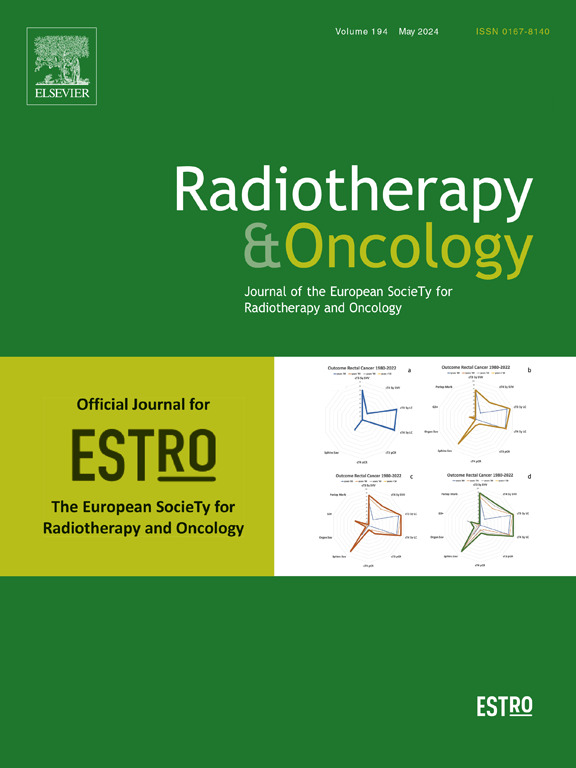口腔鳞状细胞癌术后放疗:指导术后靶区选择和划定的资料综述。
IF 4.9
1区 医学
Q1 ONCOLOGY
引用次数: 0
摘要
背景和目的:迄今为止,尚未发表一致的指南,系统地指导头颈部鳞状细胞癌(HNSCC)术后放疗(PORT)患者的原发性和结性临床靶体积(CTVs)的描绘。因此,在术后环境中ctv的描述方式存在显著的个体、机构和国家差异,导致放疗治疗的相当大的异质性。方法:由欧洲放射与肿瘤学会(ESTRO)召集多学科专家组,包括来自欧洲、北美和亚洲的放射肿瘤学家,以及外科、放射学和病理学代表。口腔鳞状细胞癌(OCSCC),其中手术后的PORT是标准的护理,首先被选为焦点。PORT的适应症,以及肿瘤亚部位和分期对术后治疗量的影响,参照现有证据和组内临床经验进行考虑。结果:我们对OCSCC的PORT适应症提出了明确的建议,并提出了一种新的侧边和非侧边OCSCC分类,以帮助指导术后淋巴结cvs的划定。结论:本文总结的证据和专家意见为OCSCC术后原发性和淋巴结ccv划分提供了新的国际共识指南所需的背景和背景。本文章由计算机程序翻译,如有差异,请以英文原文为准。
Post-operative radiotherapy for oral cavity squamous cell carcinoma: Review of the data guiding the selection and the delineation of post-operative target volumes
Background and Purpose
To date, no consensus guidelines have been published that systematically guide delineation of primary and nodal Clinical Target Volumes (CTVs) in patients who require post-operative radiotherapy (PORT) for head and neck squamous cell carcinoma (HNSCC). As a result, significant individual, institutional and national variation exists in the way that CTVs are delineated in the post-operative setting, leading to considerable heterogeneity in radiotherapy treatment.
Methods
A multi-disciplinary group of experts was convened by the European Society for Radiotherapy and Oncology (ESTRO), including radiation oncologists from Europe, North America and Asia, as well as surgery, radiology and pathology representatives. Oral cavity squamous cell carcinoma (OCSCC), where surgery followed by PORT is the standard of care, was first selected for focus. The indications for PORT, and the influence of tumour subsite and stage on post-operative treatment volumes, were considered with reference to current evidence, and clinical experience within the group.
Results
We present clear recommendations regarding the indications for PORT in OCSCC, and propose a new classification of lateralised and non-lateralised OCSCC, to help guide the delineation of post-operative nodal CTVs.
Conclusions
The evidence and expert opinion summarised in this manuscript provides the background and context required to underpin new international consensus guidelines for the delineation of primary and nodal CTVs for OCSCC in the post-operative setting.
求助全文
通过发布文献求助,成功后即可免费获取论文全文。
去求助
来源期刊

Radiotherapy and Oncology
医学-核医学
CiteScore
10.30
自引率
10.50%
发文量
2445
审稿时长
45 days
期刊介绍:
Radiotherapy and Oncology publishes papers describing original research as well as review articles. It covers areas of interest relating to radiation oncology. This includes: clinical radiotherapy, combined modality treatment, translational studies, epidemiological outcomes, imaging, dosimetry, and radiation therapy planning, experimental work in radiobiology, chemobiology, hyperthermia and tumour biology, as well as data science in radiation oncology and physics aspects relevant to oncology.Papers on more general aspects of interest to the radiation oncologist including chemotherapy, surgery and immunology are also published.
 求助内容:
求助内容: 应助结果提醒方式:
应助结果提醒方式:


